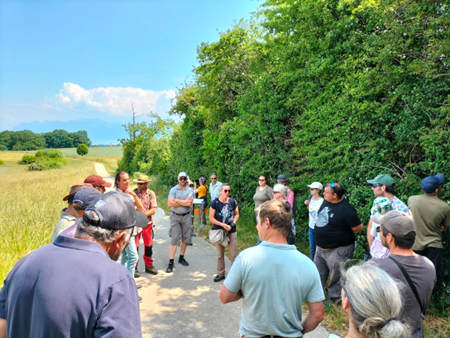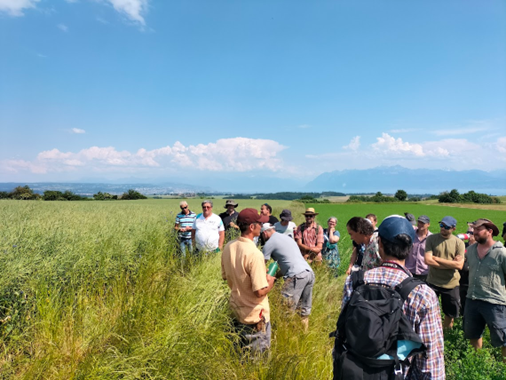Agroecology: R2D2 meets Swiss farmers
Agroecology: R2D2 meets Swiss farmers
On 7 and 8 June, two field days were held in the canton of Vaud, Switzerland, devoted to "biodiversity-promoting areas" and their key role in the functioning of agrosystems.
Organised by the Proconseil group, the event was an opportunity for farmers involved in the R2D2 project to discover innovative farming practices in the canton of Vaud and to exchange views with farmers who have been committed to the transition of their systems for over 10 years. Nicolas Cerrutti, functional biodiversity research officer, and Michael Geloen, development engineer at Terres Inovia, followed these discussions with interest.
Switzerland is rightly often held up as a model when it comes to promoting biodiversity on farms. Swiss public policies provide financial incentives and technical support for the implementation of agro-ecological practices and facilities, which are still struggling to develop in France.
Annual and perennial flowerbeds and hems (1) - known as Biodiversity Promotion Areas (BPAs) - are thus more easily adopted by farmers. Many Swiss farmers began the agro-ecological transition of their systems nearly 15 years ago. The operators in the R2D2 project have met some of them, people who are passionate about their work. Although it was financial incentives that initially led them to take the plunge, none of them would go back today...

Hedgerows are essential habitats for crop protection animals. Their role was explained in detail by Anne-Claude Jacquat, biodiversity extension officer at Prométerre. Credit: N.Cerruti- Terres Inovia
"An important source of resilience for production systems".
Fabrice Allaz, a field crop producer in Villars-Le-Terroir, joined forces with two of his neighbours 15 years ago to set up a project designed to encourage crop beneficials over a hundred hectares. With technical support from an independent biologist, he set up a network of flower strips and hemlines to create relay zones for crop beneficials, and reorganised his land parcels to reduce the size of the cultivated plots.
At the same time, he stopped ploughing and switched to direct seeding under permanent cover. Fabrice has found this new way of producing "a major source of resilience for his production system". He is delighted to have significantly reduced his inputs, particularly insecticides on his wheat and oilseed rape crops, while maintaining the same productivity levels as some of his neighbours who have not changed their practices. Fabrice attributes this success to his soil functioning better and also to better levels of biological regulation that act as a barrier to insect pests, reducing the frequency and intensity of outbreaks.
"Improving plant growth through soil microbial activity".
André Staudenmann, a farmer in Vuarrens, also uses the services provided by biodiversity to limit the use of synthetic inputs. He strongly emphasises the importance of the soil. In his view, the work done at landscape level to encourage biological regulation cannot bear fruit if crops are grown on soil that is not sufficiently biologically active. Using permanent cover, no-till and compost-based organic amendments, he aims to "boost the microbial activity of his soils to improve plant growth and immunity".

Eric Fazan, farmer, explains the role of a grass-based hem as a biodiversity support area - Credit: N.Cerruti-Terres Inovia
The central role of non-productive areas
For French farmers, it's a change of scene... They discover different farm structures (an average of 40 ha for the farms visited) and agricultural landscapes in which non-productive areas play a central role because they are valued for their ecological functions. In Switzerland, there are also financial contributions for "extenso" arable farming practices that ban the use of insecticides and fungicides.
Among the areas used to promote biodiversity, some have been in place for more than 10 years among the farmers we met. In addition, it should be noted that this country has been less affected by land consolidation than France and still has networks of old multi-strata hedgerows that provide refuge and food for many auxiliary insects such as wild and domestic bees and hoverflies. In Switzerland, BPS account for a total of 19% of agricultural land.
The development of beneficial insects
The structure of the Swiss landscape is an asset for the movement of beneficial insects and their penetration into the heart of agricultural plots. The entomologists present at these meetings recorded and sorted the insects trapped in barber jars that had been placed in the plots visited two days before the event.
These pots were teeming with insects useful to the farmer, such as ground beetles and spiders. Generally speaking, the abundance and diversity of soil predator communities was greater than in the plots monitored in France.
We find ourselves in very different production contexts and, as a result, not everything we have seen can be transposed as it stands. However, the richness of the Franco-Swiss exchanges, as well as the hindsight gained on practices that the farmers in the R2D2 project are only just beginning to explore, will serve, we hope, as a catalyst in the appropriation of innovations.
(1) Hemlocks are extensive, multi-annual strips of herbaceous vegetation. As a permanent feature, the hem provides food, shelter and a place to overwinter for numerous natural enemies. It is a linear element, highly suited to the networking of natural environments.